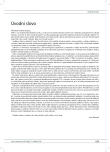Absence Status in Geriatric Patient with Recent Diagnosis of Idiopathic Generalised Epilepsy – a Case Report
Authors:
P. Bušek; M. Kucharík; J. Fiksa; E. Nešpor
Authors‘ workplace:
Neurologická klinika 1. LF UK a VFN Praha
Published in:
Cesk Slov Neurol N 2008; 71/104(6): 722-725
Category:
Case Report
Overview
We report a case of a patient with recurrent states of confusion which only began at an advanced age. Based on EEG, absence status epilepticus was determined to be the cause of the above states. Judging by the nature of the ictal and interictal EEG finding and a history of absence episodes in childhood and adolescence, this appeared to be a case of primary idiopathic generalised epilepsy. Even though there were no additional absence episodes reported in the patient’s history at a later stage of her life in spite of the fact that she was not on antiepileptic medication, “phantom absence seizures” cannot be excluded judging by interictal EEG results and we assume that we may have to do with a case of idiopathic generalised epilepsy with phantom absences. What is particular in this case is the diagnosis of idiopathic generalised epilepsy made at an advanced age in a geriatric patient.
Key words:
absence – ament condition – phantom absences – idiopathic generalised epilepsy – status epilepticus
Sources
1. Pérez-Lázaro C, Santos S, Garcés-Redondo M, Piñol-Ripoll G, Fabre‑Pi O, Mostacero E et al. Ictus amnésico por infarto hipocámpico. Rev Neurol 2005; 41(1): 27–30.
2. Carrera E, Bogousslavsky J. The thalamus and behavior: effects of anatomically distinct strokes. Neurology 2006; 66(12): 1817–1823.
3. Marín-García E, Ruiz-Vargas JM. Amnesia global transitoria: una revisión. I. Aspectos clínicos. Rev Neurol 2008; 46(1): 53–60.
4. Panayiotopoulos CP. Idiopathic generalised epilepsies. In: Panayiotopoulos CP (ed). The epilepsies. Seizures, Syndromes and Management. Oxfordshire: Bladon Medical Publishing 2005 : 271–348.
5. Bauer G, Bauer R, Dobesberger J, Benke T, Walser G, Trinka E. Absence status in the elderly as a late complication of idiopathic generalized epilepsies. Epileptic Disord 2007; 9(1): 39–42.
6. Genton P, Ferlazzo E, Thomas P. Absence status epilepsy: delineation of a distinct idiopathic generalized epilepsy syndrome. Epilepsia 2008; 49(4): 642–649.
7. Vuilleumier P, Assal F, Blanke O, Jallon P. Distinct behavioral and EEG topographic correlates of loss of consciousness in absences. Epilepsia 2000; 41(6): 687–693.
8. Trinka E. Absences in adult seizure disorder. Acta Neurol Scand 2005; 182 (Suppl): 12–18.
9. Koutroumanidis M, Aggelakis K, Panayiotopoulos CP. Idiopathic epilepsy with generalized tonic-clonic seizures only versus idiopathic epilepsy with phantom absences and generalized tonic-clonic seizures: One or two syndromes? Epilepsia. In press 2008.
10. Panayiotopoulos CP, Koutroumanidis M, Giannakodimos S, Agathonikou A. Idiopathic generalised epilepsy in adults manifested by phantom absences, generalised tonic-clonic seizures, and frequent absence status. J Neurol Neurosurg Psychiatr 1997; 63(5): 622–627.
Labels
Paediatric neurology Neurosurgery NeurologyArticle was published in
Czech and Slovak Neurology and Neurosurgery

2008 Issue 6
Most read in this issue
- Multiple Sclerosis and Magnetic Resonance Imaging: Present Status and New Trends
- Adult Age Sleep Apnoea
- Subacute Hypertensive Reversible Leukoencephalopathy – a Case Report
- Protein 14-3-3 Detection in Cerebrospinal Fluid – Clinico-Pathological Correlation
